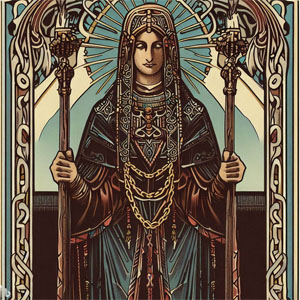The origins of the Tarot are shrouded in mystery and there is no consensus on its true history. However, it is believed that the Tarot originated in Italy during the late 14th century as a deck of playing cards called the Tarocchi and only later evolved into a tool for divination and esoteric purposes.
Some historians trace the Tarot’s origins back to ancient Egypt or even the Kabbalah, but there is little concrete evidence to support these claims. Others believe that the Tarot was brought to Europe by gypsies or by the Moors during their occupation of Spain.
The earliest known Tarot decks were produced in Italy during the 14th century, and were used primarily for playing games such as Tarocchi and Trionfi. “Tarocchi” is the Italian word for “Tarot,” and the history of the Tarocchi is closely intertwined with the history of the Tarot. These decks were similar to modern playing cards, but with the addition of a set of 22 symbolic cards called the Major Arcana. These games were similar to modern-day Bridge or Whist, and were popular among the Italian aristocracy.
The earliest Tarocchi decks consisted of 78 cards: 56 suited cards (similar to playing cards), and 22 trumps (the Major Arcana). The trumps were highly symbolic and often depicted allegorical or mythological scenes.
The earliest known Tarocchi deck is the Visconti-Sforza deck, which was created in the late 14th century for the ruling families of Milan. This deck featured hand-painted, highly detailed illustrations of the courtly life of the time, as well as allegorical images based on classical mythology.
Over the years, numerous other Tarocchi decks were created in Italy, each with its own unique style and symbolism. Many of these decks featured images of the four suits of the Tarot (swords, cups, coins, and wands), as well as the 22 Major Arcana cards.
In the early days of the Tarocchi, different regions of Italy produced their own unique versions of the deck. For example, the Tarocchi Bolognesi was produced in the city of Bologna and featured a distinct style of illustration.
It wasn’t until the 18th and 19th centuries that the Tarocchi began to be used for divination and esoteric purposes, similar to the Tarot.
Madame Lenormand is often associated with Tarot. She was a French fortune-teller who lived in the late 18th and early 19th centuries, and was renowned for her accuracy in predicting the future. Madame Lenormand did not use the Tarot exclusively, but rather developed her own system of divination using a set of 36 cards that are now known as the Lenormand cards. She gained popularity after it became known that she read for the French aristocracy.
The Lenormand cards are similar to the Tarot in that they feature symbolic images and can be used for divination and spiritual guidance. However, they differ from the Tarot in several ways. First, the Lenormand cards are smaller and more compact than Tarot cards, and are typically read in sets of three or more. Second, the Lenormand cards are less complex in terms of their symbolism, with each card representing a specific object or situation (e.g. the Ship card represents travel or a journey).
Despite their differences, the Lenormand cards have become a popular tool for divination and self-discovery, and have inspired numerous decks and interpretations over the years. Madame Lenormand herself remains a legendary figure in the world of divination, known for her skill and insight into the mysteries of the human experience.
During this time, as well, several influential occultists and mystics, such as Eliphas Levi and Papus, wrote books on the Tarocchi and helped to popularize its use as a tool for spiritual guidance and self-discovery.
Today, the Tarocchi is still used primarily for playing games in Italy, but it has also become a popular tool for divination and esoteric study in other parts of the world. Many Tarot decks, such as the Marseille Tarot, are based on the traditional Tarocchi designs and symbolism.
The earliest known Tarot decks were hand-painted and highly prized, but as the popularity of the Tarot grew, mass-produced decks became more common. In the 19th century, advances in printing technology allowed for larger print runs and more affordable decks.
The most famous Tarot deck is probably the Rider-Waite-Smith deck, which was created by artist Pamela Colman Smith and published by A.E. Waite in 1909. This deck features vivid, highly detailed illustrations that have become iconic in the world of Tarot.
The Tarot was not without controversy in its early days. Some religious leaders and moral authorities condemned the Tarot as a tool of Satan, while others saw it as a harmless diversion. Today, the Tarot is generally accepted as a legitimate tool for spiritual exploration and personal growth.
The Tarot has inspired numerous other divination systems, such as Lenormand cards, oracle cards, and runes. Many of these systems use similar symbolism and imagery to the Tarot, but with their own unique twists.
The Tarot has been popularized in popular culture through books, films, and television shows. For example, the character of Madame Sosostris in T.S. Eliot’s poem “The Waste Land” is based on a real-life Tarot reader, and the TV show “Twin Peaks” featured several scenes involving Tarot cards.
Despite its popularity, the Tarot remains a highly individualized tool. Each reader brings their own interpretation and intuition to the cards, and there is no one “right” way to use the Tarot. This has led to a diverse and vibrant Tarot community, with many different approaches and perspectives.
Hits: 36

